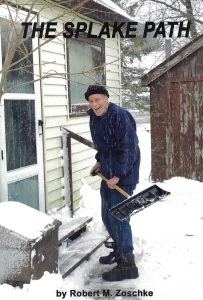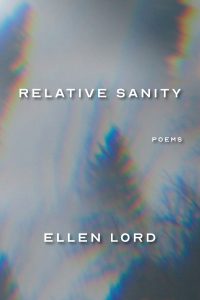Review by Mack Hassler
 I had said in an earlier review of one of the many collections by Splake as well as in Clutch collections by Zoschke, which contain a lot of Splake, that I thought he was winding down his enormous output of short poems. In fact, I used an image of hospice for the taming of his fierce , ideologic presentation of his work as our own UP version of a Kerouac “beatness.” I was wrong on both counts. Splake is never done, and he is just as “fierce” “on the road” as ever. But I do want to contrast here his self promotion and energetic “beatness” to the quiet and more elegant first book of poems by Ellen Lord. Which of the two is the more authentic voice for UP literature? Splake is the rough and tumble Yooper—actually born and taught downstate but then gone “on the road” and eagerly adopted himself to Copper Country. He is a good photographer also. So this new book about his work by Zoschke, with some new poems, includes many fine photos of the hard winter in Calumet; but more importantly pictures of the deep drifts of books and papers alongside Splake’s aging and gaunt visage. With the photos, The Splake Path is mainly a narrative by Zoschke of his pilgrimage North to visit the old Beat and a commentary on Splake’s work. Zoschke does a fine job.
I had said in an earlier review of one of the many collections by Splake as well as in Clutch collections by Zoschke, which contain a lot of Splake, that I thought he was winding down his enormous output of short poems. In fact, I used an image of hospice for the taming of his fierce , ideologic presentation of his work as our own UP version of a Kerouac “beatness.” I was wrong on both counts. Splake is never done, and he is just as “fierce” “on the road” as ever. But I do want to contrast here his self promotion and energetic “beatness” to the quiet and more elegant first book of poems by Ellen Lord. Which of the two is the more authentic voice for UP literature? Splake is the rough and tumble Yooper—actually born and taught downstate but then gone “on the road” and eagerly adopted himself to Copper Country. He is a good photographer also. So this new book about his work by Zoschke, with some new poems, includes many fine photos of the hard winter in Calumet; but more importantly pictures of the deep drifts of books and papers alongside Splake’s aging and gaunt visage. With the photos, The Splake Path is mainly a narrative by Zoschke of his pilgrimage North to visit the old Beat and a commentary on Splake’s work. Zoschke does a fine job.
 Relative Sanity, Ellen Lord’s collection of poems, is beautifully printed with delicate feather designs that suggest native Americans in Charlevoix County where she lives and works as therapist treating cases of addiction and trauma. Her poems are delicate and lovely like the feather designs, touching the reader gently. My favorite is one in which a cancer patient and former convict speaks at the end:
Relative Sanity, Ellen Lord’s collection of poems, is beautifully printed with delicate feather designs that suggest native Americans in Charlevoix County where she lives and works as therapist treating cases of addiction and trauma. Her poems are delicate and lovely like the feather designs, touching the reader gently. My favorite is one in which a cancer patient and former convict speaks at the end:
“I want to feel the sun on my face,
see summer roll in lazy and hot,
a soft breeze on my skin—
I want to look up one last time,
into a cleansing rain.” (p.13)
Lord does not try to invent a whole poetic of Whitmanesque and modern “Beat” sharpness as Zoschke and Splake do with his work. She is content to lean into standard lining, metrics and imagery using the form , I think, as cushion to ease the deep sentiment. Unlike Splake she does not nail us with assertiveness. Rather like a good counselor or therapist, she leaves us wanting more.
These two poets both have models from the general literature outside of the UP. So we are left to decide for ourselves whether the truer poetry of the North comes as the great ego scream of the Beat or as the softer and more cleansing voice of the lover. Both poets love what they do. Splake has the blast of the Old Testament prophet. The work of Lord has the gentleness of the New Testament shepherd. I think together they tell us a lot about poetry itself.



